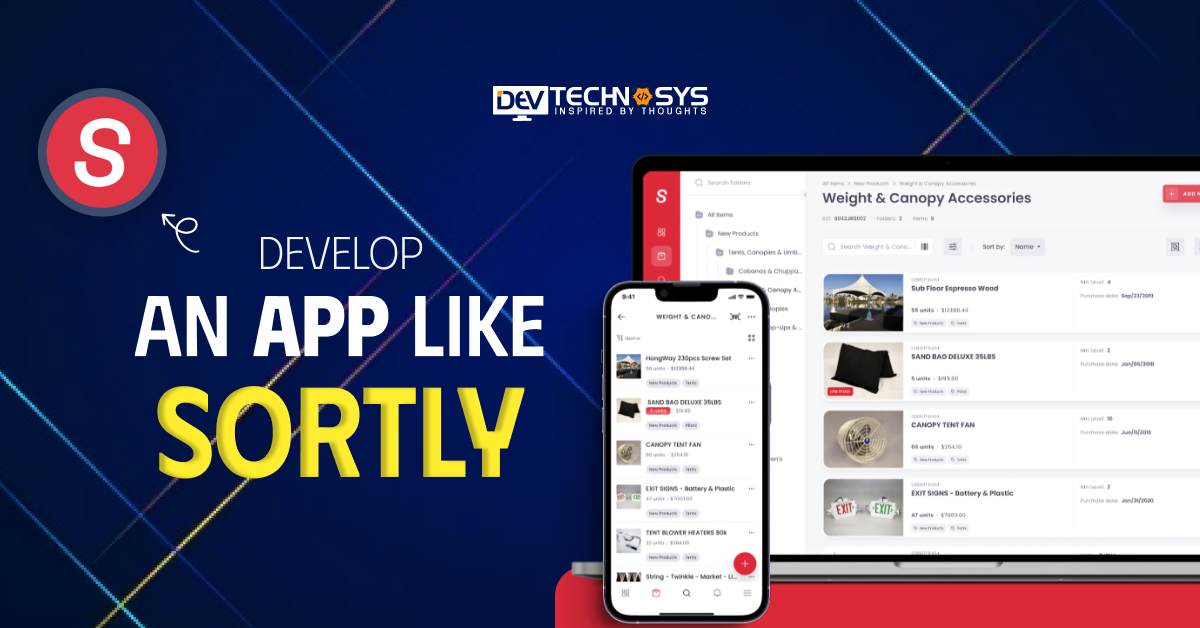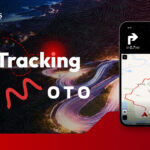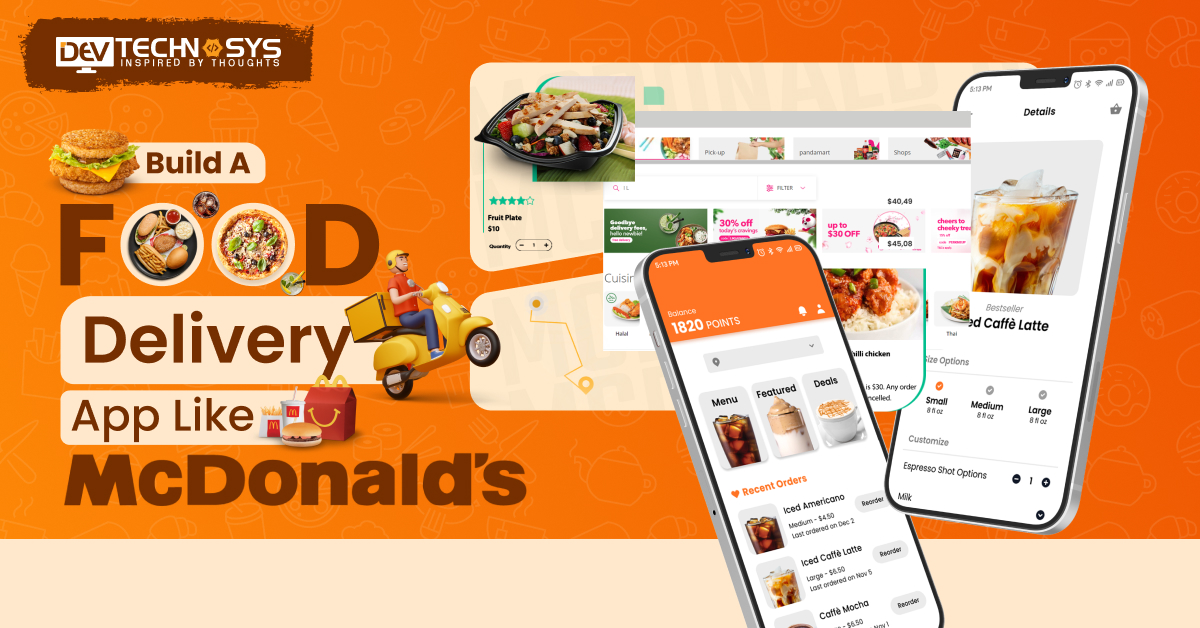From small startups to large enterprises, everyone needs to manage their inventories not only for smooth operations but also for increasing profitability. Handling a higher number of operations, inventory management apps play a vital role in managing inventory through automated operations.
Over the last few years, an inventory management app like Sortly has been in higher demand due to its advanced functionalities, such as real-time tracking of assets, stocks, supplies, and customized tags.
Look what I found: the inventory management applications market was valued at around $3.58 billion in 2024. This is expected to grow to around $5.08 billion by the end of 2030.
The data above indicates that investing in asset tracking apps presents a highly profitable opportunity for businesses.
Welcome to this dynamic blog, where we will explore how to develop an app like Sortly, its benefits, features, and more.
What is Sortly?
Sortly is a mobile app that helps users to manage their inventory visually. It allows users to easily track and organize their assets, supplies, and equipment. The software allows you to create custom catalogs, scan QR codes or barcodes, and attach images to objects for easier identification.
Sortly has a simple, straightforward interface that works on all devices, making it ideal for organizations that need to manage inventory efficiently and in real-time.
- Visual Cataloging
- Barcode & QR Code Scanning
- Multi-Device Access
- Reporting & Analytics
Market Analysis of Inventory Management Applications
- In 2024, the market for inventory tracking systems was estimated to be worth $3.58 By the end of 2030, this is anticipated to increase to almost $5.08 billion.
- As per the recent survey, warehouse management apps are projected to increase with a compound annual growth rate of 7% from 2025 to 2030.
- With a revenue share of over 34% in 2024, the North American region led the asset tracking applications market.
- Among the major companies in the Inventory optimization application market are IBM Corporation, Microsoft Corporation, and Oracle Corporation.
- The market for stock management platforms is expanding rapidly due to companies’ need to improve operational efficiency, cut expenses, and optimize supply chains.
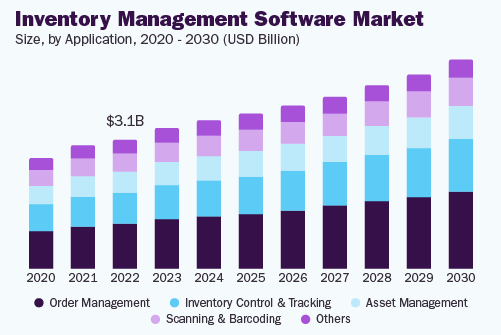
10 Best Inventory Management Apps Like Sortly
This table lists iOS, Android, and Web apps with ratings, downloads, and launch years to provide you with a complete look at top inventory management apps.
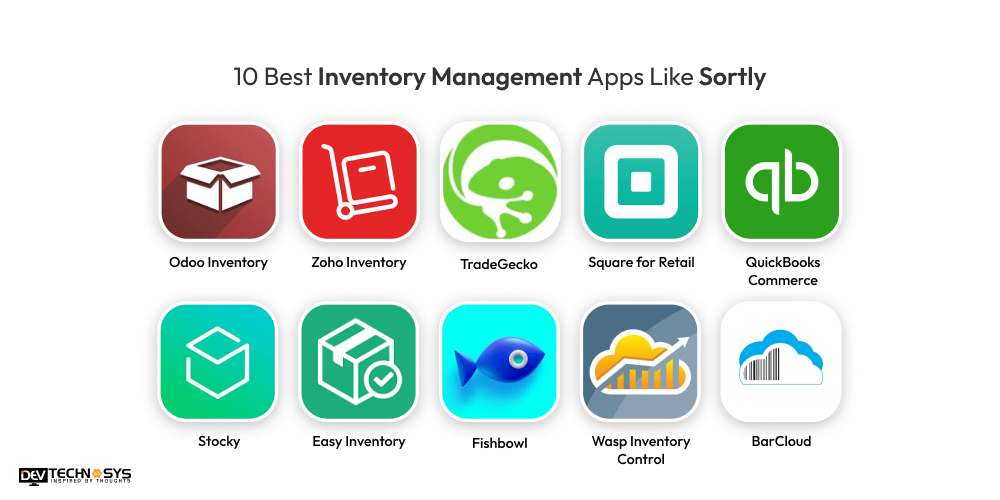
| Applications | Download Users | Stores Ratings | Apps Launched On | Platform Accessibility |
| Odoo Inventory | 1M+ | 4.3 | 2005 | Android, iOS, Web |
| Zoho Inventory | 500K+ | 4.6 | 2011 | Android, iOS, Web |
| TradeGecko | 100K+ | 4.3 | 2012 | Android, iOS, Web |
| Square for Retail | 500K+ | 4.5 | 2017 | Android, iOS, Web |
| QuickBooks Commerce | 100K+ | 4.3 | 2003 | Android, iOS, Web |
| Stocky | 100K+ | 4.3 | 2016 | iOS, Web |
| Easy Inventory | 50K+ | 4.3 | 2014 | Android, Web |
| Fishbowl | 50K+ | 4.1 | 2001 | Windows, Web |
| Wasp Inventory Control | 50K+ | 4.0 | 1994 | Windows, Web |
| BarCloud | 10K+
|
4.3 | 2014 | Android, Web |
Why Entrepreneurs Invest in Inventory Management App Development?
Investing in inventory management Android app development allows entrepreneurs to streamline operations, save costs, make better decisions, scale efficiently, and enhance customer experience. Entrepreneurs invest in inventory management app development for several compelling reasons. Here are five key motivations:
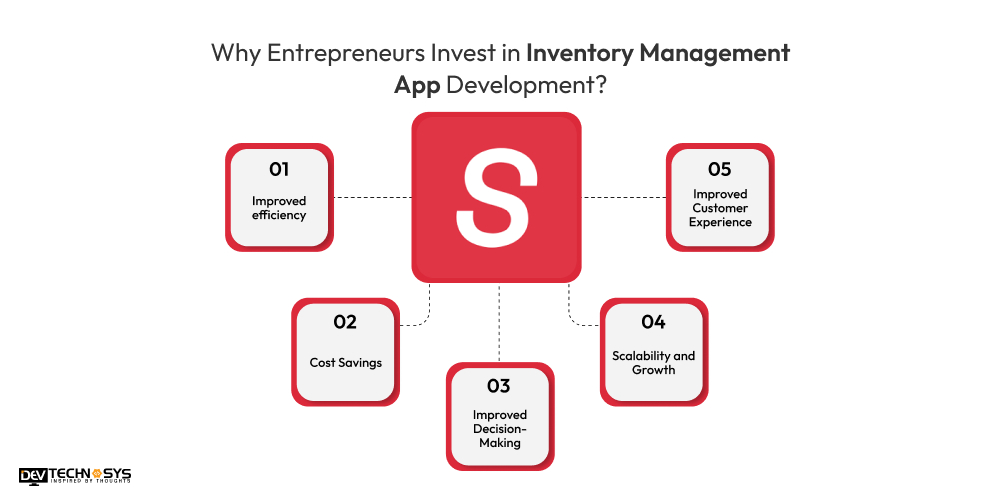
1. Improved efficiency
Handling inventory manually can be time-consuming and error-prone. An supply chain management app automates a variety of tasks, including stock tracking, order fulfillment, and supply chain management.
This saves time on manual data entry, allowing entrepreneurs to focus on building their firm. With real-time updates, entrepreneurs can immediately obtain the data they require, avoiding unnecessary delays and bottlenecks in their workflow.
2. Cost Savings
These apps prevent overstocking and stockouts by delivering correct inventory insights. Overstocking takes up capital and storage space, whereas stockouts can result in lost sales and low customer satisfaction.
A competent inventory management tool optimizes stock levels, ensuring that the business only keeps the appropriate amount of inventory.
3. Improved Decision-Making
Entrepreneurs can make better decisions now that they have access to reliable, real-time data.
inventory control apps frequently offer capabilities like as reporting, analytics, and trend forecasts that assist business leaders in evaluating sales patterns, demand variations, and supplier performance.
4. Scalability and Growth
As firms expand, manual processes fail to keep up. Inventory management software grow with the company, easily accepting new product lines, different locations, and large quantities of orders.
As we discussed earlier with enterprise software development services provider, entrepreneurs invest in these programs to ensure that their inventory system can handle growth without adding complexity.
5. Improved Customer Experience
Having correct inventory information at all times allows businesses to fulfill client requests quickly. Apps enable businesses to track product availability and provide customers with timely updates on order status. A flawless inventory system immediately adds to client happiness, loyalty, and repeat business.
7 Robust Steps to Develop an App Like Sortly
To make an app like Sortly, you need to organize proper planning and follow the basic steps that explain each process in detail. These steps lead the way to successful stock management app development. So, here is the powerful inventory management mobile app development process:
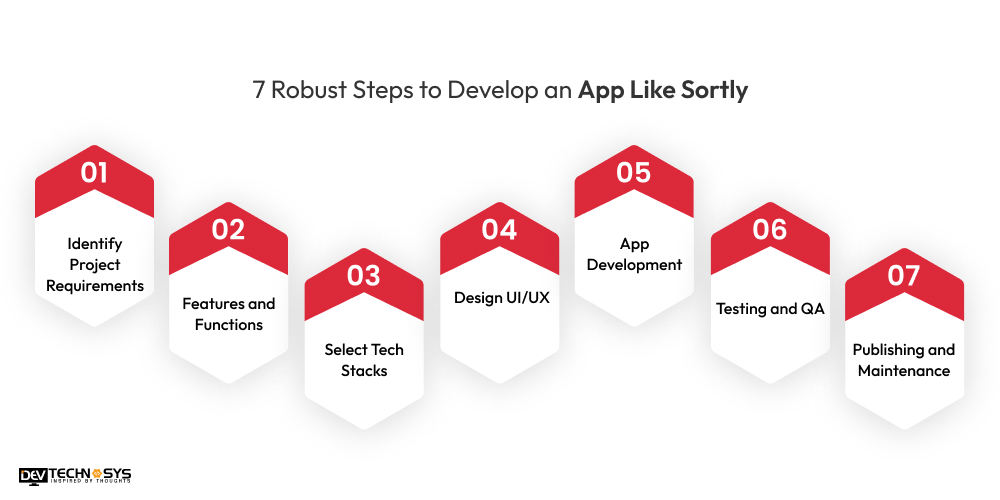
1. Identify Project Requirements
In the first step of development, identify the core and advanced requirements of your project and prepare a list of needs that can reduce the confusion. Make a plan for how to achieve selected goals and how you can compete with other existing product management apps.
| What are your app’s basic or core requirements? |
| Clear your app’s future goals. |
| Which inventory control apps are more successful and trending in this competitive market? |
2. Features and Functions
Move to the second stage of development, hire dedicated developers to identify the basic and premium features of your product management apps. It includes various types of features such as real-time inventory tracking, cloud storage, automated alerts, QR code scanning, and multi-location support.
| What are your app’s basic or premium features and functions? |
| Observe the existing warehouse management apps for the best features. |
| Make an organized sheet of features and functions to reduce data redundancy. |
3. Select Tech Stacks
Let’s come to the third stage of development, choosing the best tech stacks is a vital part of the overall development process. It includes various tech stacks such as Java and Python(For Backend), CSS, HTML, and Javascript (For Frontend), and unit and functional testing(For testing).
| Which type of tech stacks are used in your Sortly clone app development? |
| Define your scalability requirements. |
| Choose advanced or basic tech stacks. |
4. Design UI/UX
Moving to the fourth stage of development, you can hire mobile app developers that has expertise to design a user-friendly interface to quickly interact. It involves various designing phases such as layout, premium templates, high-quality themes, elements UI, and more.
| What are wireframes in UX design? |
| What tools do you use for prototyping? |
| How do you ensure a responsive design? |
5. App Development
In the fifth stage of development, assemble a highly skilled development team to write the real code to build the strong backend processes. It includes various phases such as third-party integrations, API integrations, database integrations, functions, module, and more.
| Do you want to create hybrid or native apps? |
| Choose highly talented mobile app developers. |
| Integrate a high number of features and functions. |
6. Testing and QA
Let’s connect to the sixth stage of development and conduct robust testing techniques such as unit, functional, integration, and security testing to test the app to fix ongoing bugs. After that, make sure all the features and functions of the app are working correctly and performing at their peak.
| Make sure that all features and functions are working properly |
| Use various testing methods, such as functional and usability testing. |
| Check the app’s security measurements. |
7. Publishing and Maintenance
To move to the final stage of development, hire an experienced mobile app development company to publish the app on the live phase, such as Android and iOS. Conduct maintenance services such as fixing bugs and glitches, updating the older features, and adding new enhancements.
| Launch your app on selected platforms like Android and iOS. |
| Use the best marketing techniques. |
| Assign the post-maintenance phases to maintain the app’s performance. |
10 Must-Have Trending Features of Apps Like Sortly
These features enhance efficiency, accuracy, and scalability, making inventory management easier and more efficient. Here are 10 must-have trending features for inventory management apps like Sortly:
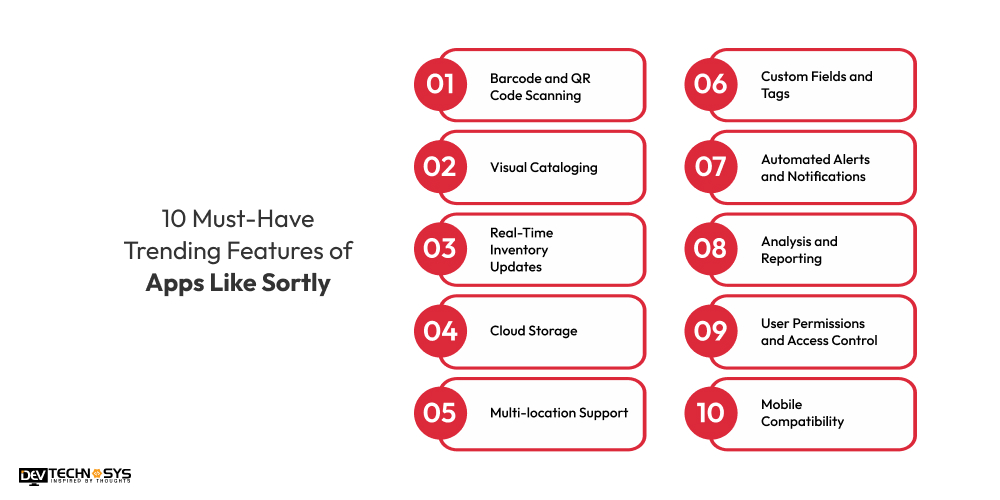
1. Barcode and QR Code Scanning
Scanning barcodes or QR codes, a key element for instant item identification, speeds up inventory tracking and reduces manual entry errors.
2. Visual Cataloging
Sortly alternatives enable users to upload photographs of objects, improving inventory management by allowing them to visually track and categorize their assets for simple identification.
3. Real-Time Inventory Updates
App similar to Sortly synchronizing inventory data across devices guarantees real-time updates, allowing users to check stock levels, availability, and transactions from any location seamlessly.
4. Cloud Storage
Cloud-based storage enables safe, remote access to inventory data from different devices, ensuring that data is not lost and can be readily shared within teams.
5. Multi-location Support
The similar app like Sortly, allows entrepreneurs to manage inventory across multiple warehouses or storefronts, offering visibility into stock levels at each location.
6. Custom Fields and Tags
If you develop hospital inventory management software, users can customize the app’s fields and tags to meet their individual inventory needs, allowing them to categorize and filter products.
7. Automated Alerts and Notifications
Sortly similar apps offer notifications about low stock, expiration dates, and stock discrepancies to help firms remain on top of their inventory demands and minimize shortages or overstocking.
8. Analysis and Reporting
The Sortly alternatives offer advanced reporting and analytics technologies that provide insights into sales trends, inventory levels, and product performance, allowing for data-driven decisions.
9. User Permissions and Access Control
The inventory management web app enables firms to configure role-based access, ensuring that only authorized workers can modify important inventory data.
10. Mobile Compatibility
Sortly clone app enables users to monitor inventory on the go, scan products, and instantaneously update stock data, providing flexibility and convenience.
The Cost to Develop an App Like Sortly
The cost to develop an app like Sortly can range from $8,000 to $25,000, depending on several factors. These include the complexity of features (barcode scanning, visual cataloging, real-time updates), design, platform (iOS, Android, or both), and development location (offshore vs. local teams).
Additional costs can include backend infrastructure, ongoing maintenance, updates, and integration with other systems. More advanced features like cloud storage, multi-location support, and analytics may increase AI inventory management software development cost. A clear feature set and timeline will help refine the total cost.
| Inventory Management App Development | Estimated Cost | Time Frame |
| Normal App Development | $8000 – $12000 | 2 to 5 Months |
| Mid-Premium App Development | $14000 – $19000 | 6 to 8 Months |
| High-Premium App Development | $25000+ | 9+ Months |
What are the Factors That Affect Inventory Management App Development Cost?
Back-end complexity, application design, development team expertise, support and maintenance requirements, and the inclusion of simple vs. advanced features all influence the cost to create inventory management app like Sortly. Customization, scalability, and interaction with third-party systems can all contribute to longer development times and higher expenses.
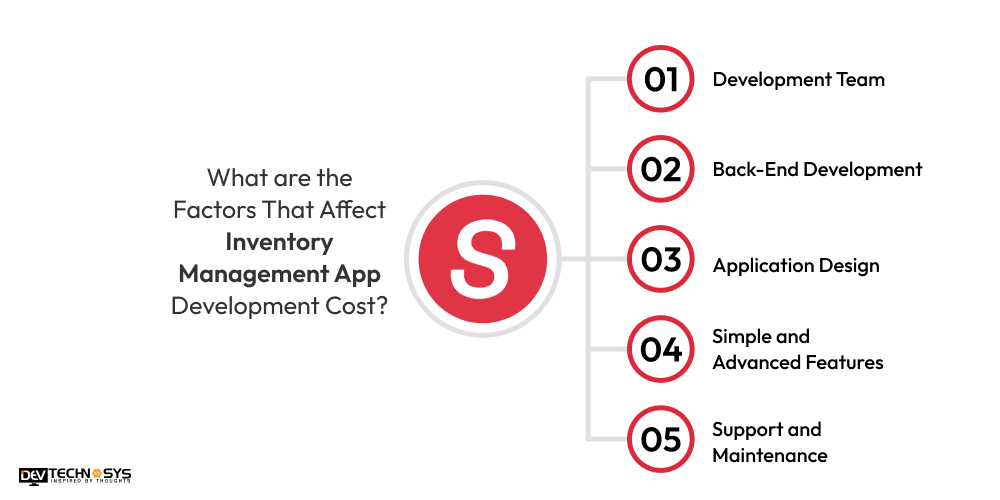
1. Development Team
The development team’s location and experience have a significant impact on costs. Hiring developers in areas with higher labor costs (such as North America or Western Europe) raises overall costs. Experienced developers who specialize on mobile apps, cloud integration, and security typically increase the cost to develop inventory management app like Sortly.
| Developer’s Experience Level | Cost Estimation |
| Entry-Level Developer | $15 – $18/ Per Hour |
| Mid-Level Developer | $18 – $22/ Per Hour |
| Senior-Level Developer | $25+ / Per Hour |
2. Back-End Development
Back-end development entails creating the server, database, and API structures. A strong backend enables real-time data synchronization, cloud storage, and secure access. Complex back-end design that includes scalability, multi-location support, or third-party connectors will increase development time and expense.
| Backend Development | Cost Estimation |
| Basic Backend Process | $10,000 – $18,000 |
| Premium Backend Process | $20,000 – $28,000 |
3. Application Design
UX and UI design have a big impact on app development expenses. A visually beautiful, intuitive design necessitates competent designers, which might raise inventory management mobile app development cost. Custom designs and elaborate layouts for mobile and web platforms complicate the design process, increasing the cost to build inventory management app like Sortly.
| Design Quality | Cost Estimation |
| Basic Design | $8,000 – $12,000 |
| Complex Design | $15,000 – $22,000 |
4. Simple and Advanced Features
The complexity and diversity of characteristics influence development costs. Basic functions like stock tracking and barcode scanning are less expensive, whereas sophisticated features like real-time analytics, multi-location capabilities, and integrations with third-party software (e.g., ERP systems) necessitate more time and resources, raising the total cost.
| Features | Cost Estimation |
| Core Features(Visual Cataloging and Real-Time Inventory Updates) | $8,000 – $10,000 |
| Advanced Features(Custom Fields & Tags and Advanced Analytics & Reporting) | $13,000 – $19,000 |
5. Support and Maintenance
Post-launch support and maintenance are important to app longevity. Costs for bug patches, upgrades, and server maintenance must be considered. Ongoing support, such as software upgrades and security patches, keeps the app viable and competitive, increasing long-term expenditures.
| Maintenance Phase | Cost Estimation |
| Simple Maintenance Phase | $2,000 – $4,000/year |
| Complex Maintenance Phase | $7,000 – $9,000/year |
5 Money-Making Techniques of Inventory Management Apps like Sortly
It’s good to create a mobile app like Sortly, it offer a variety of revenue-generating strategies while also providing useful business services. Here are five important ways these apps profit:
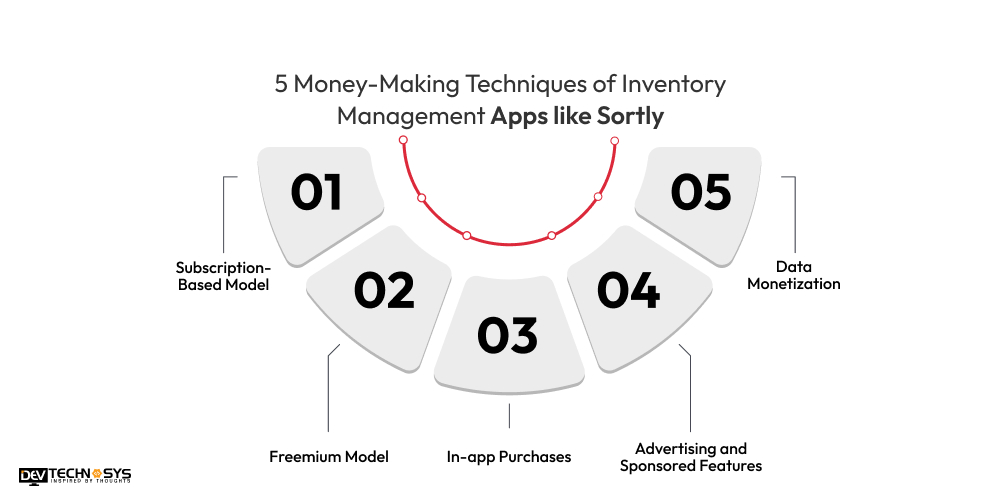
1. Subscription-Based Model
The best inventory management software operates on a subscription basis, with businesses able to choose between monthly or annual contracts. These plans can range from basic to premium, with higher-paying customers getting more advanced capabilities like multi-location support, personalized reporting, and unlimited storage. Recurring subscriptions provide a consistent revenue source that can grow alongside the app’s user base.
2. Freemium Model
The freemium model gives customers free access to a restricted set of functions while charging a premium for more advanced options. For example, consumers may receive basic stock tracking and limited storage for free, but must pay for additional features like as advanced analytics, barcode scanning, or cloud synchronization.
3. Advertising and Sponsored Features
To earn additional revenue, several warehouse management apps include adverts or sponsored features. While this technique is more popular with free apps, it can also include showing third-party adverts or working with firms that provide services related to the target demographic, such as suppliers or shipping providers.
4. In-app Purchases
In-app purchases enable businesses to purchase extra features or services as needed. For example, a company may acquire add-ons like as extra user licenses, increased storage capacity, or access to advanced inventory analytics. According to the on-demand app development company, this approach offers a flexible revenue source, appealing to enterprises who pay just for the required features.
5. Data Monetization
Many inventory apps collect useful information about market trends, inventory turnover, and supply chain activity. With user approval, this aggregated data can be anonymized and sold to research organizations, suppliers, or enterprises seeking industry insights. This data monetization technique may generate a passive cash stream for app creators.
Conclusion
In this blog, we discussed in detail how to develop an app like Sortly and why most entrepreneurs are ready to invest in it. We hope that you have cleared all your doubts regarding the Sortly app development cost and that you have an idea of what features must be integrated into your project. We also provide premium money-making methods that can easily generate higher revenue streams. So, it’s great to invest in inventory management app development; it can take your business to the next level.
If you are planning to create an app like Sortly, then connect with a supply chain management software development company to receive cost-effective solutions.
Frequently Asked Questions
Q1. How Much Does It Cost To Develop an App Like Sortly?
The cost to build an app like Sortly typically ranges from $8,000 to $25,000, depending on features, platform, design complexity, and the development team’s location and expertise.
Q2. How Much Time Does It Take To Make an App Like Sortly?
It typically takes 3 to 6 months to create an app like Sortly, depending on the complexity of features, design requirements, platform (iOS, Android, Web), and the development team’s efficiency and resources.
Q3. What Features Should Be Included in an Inventory Management App Like Sortly?
An inventory management app like Sortly should include barcode scanning, real-time updates, cloud storage, multi-location support, visual cataloging, custom fields, alerts & notifications, advanced analytics, and user access control for efficient tracking.
Q4. How Can I Monetize My Inventory Management App?
You can monetize your Inventory tracking app through subscription models, freemium features, in-app purchases, advertising, premium upgrades, data insights sales, or custom solutions for enterprise clients, depending on your target market.
Q5. Which Platforms Should the App Be Developed For?
To maximize reach, the app should be developed for iOS, Android, and a Web version. This ensures accessibility across mobile devices and desktops, catering to businesses managing inventory on multiple platforms.
